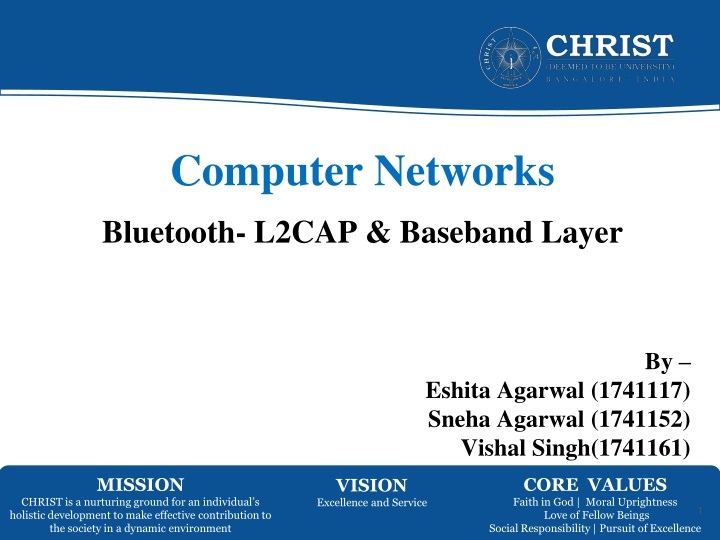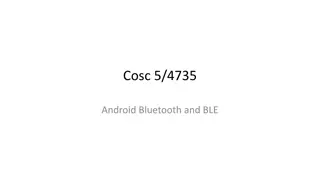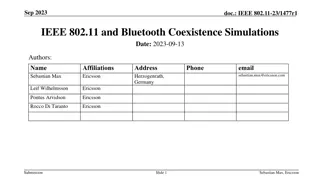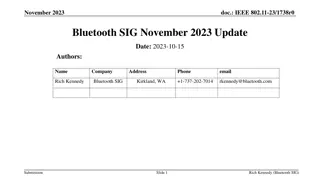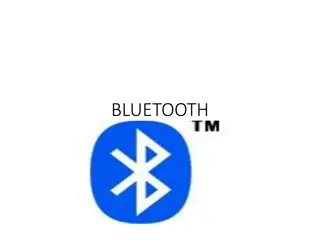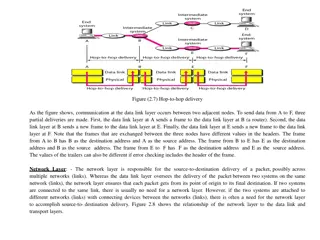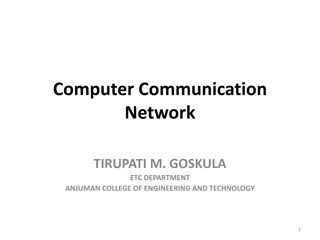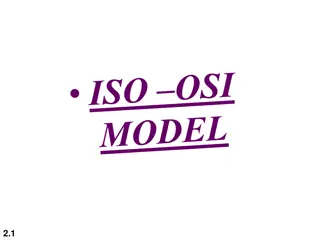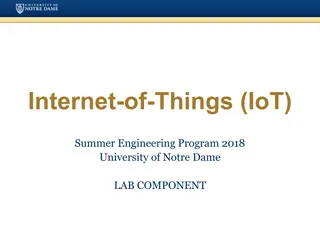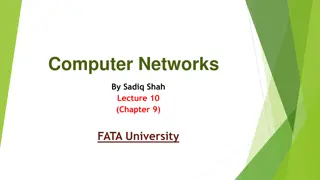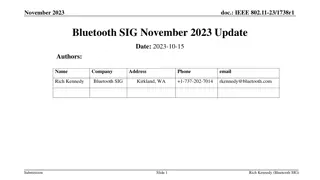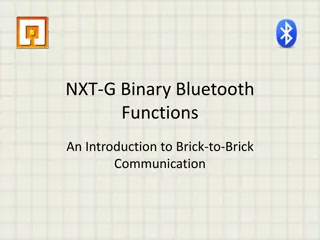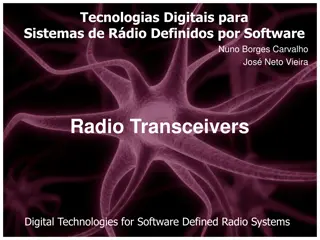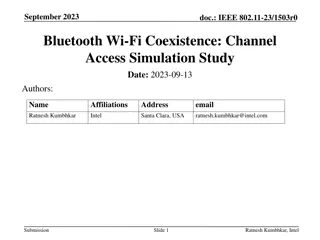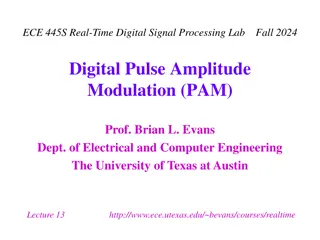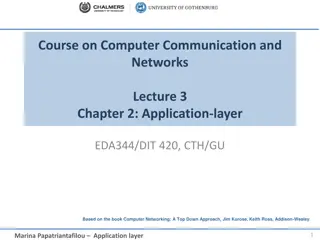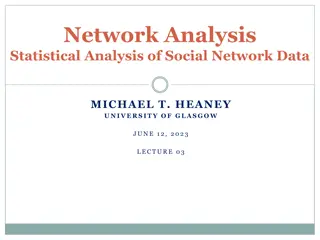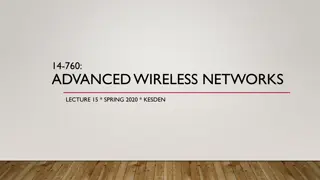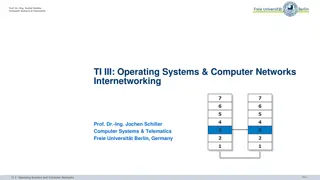Bluetooth in Computer Networks: L2CAP & Baseband Layer
Integration of Bluetooth technology in computer networks through the L2CAP and Baseband layer. Learn about the functionality, applications, and architecture of Bluetooth in CHRIST Deemed to be University. Dive into the details of Logical Link Control and Adaptation Protocol (L2CAP) and more. Enhance your understanding of wireless LAN technologies for seamless device connectivity."
Uploaded on Feb 25, 2025 | 0 Views
Download Presentation

Please find below an Image/Link to download the presentation.
The content on the website is provided AS IS for your information and personal use only. It may not be sold, licensed, or shared on other websites without obtaining consent from the author.If you encounter any issues during the download, it is possible that the publisher has removed the file from their server.
You are allowed to download the files provided on this website for personal or commercial use, subject to the condition that they are used lawfully. All files are the property of their respective owners.
The content on the website is provided AS IS for your information and personal use only. It may not be sold, licensed, or shared on other websites without obtaining consent from the author.
E N D
Presentation Transcript
Computer Networks Bluetooth- L2CAP & Baseband Layer By Eshita Agarwal (1741117) Sneha Agarwal (1741152) Vishal Singh(1741161) MISSION CORE VALUES Faith in God | Moral Uprightness Love of Fellow Beings Social Responsibility | Pursuit of Excellence VISION Excellence and Service CHRIST is a nurturing ground for an individual s holistic development to make effective contribution to the society in a dynamic environment 1
CHRIST Deemed to be University Bluetooth Bluetooth is a wireless LAN technology designed to connect devices of different functions such as : telephones, notebooks, computers (desktop and laptop), cameras, printers, etc. A Bluetooth LAN is an ad hoc network, which means that the network is formed spontaneously; Excellence and Service 2
CHRIST Deemed to be University Applications of Bluetooth Peripheral devices such as a wireless mouse or keyboard can communicate with the computer through this technology. Monitoring devices can communicate with sensor devices in a small health care centre. Home security devices can use this technology to connect different sensors to the main security controller. Conference attendees can synchronize their laptop computers at a conference. Excellence and Service 3
CHRIST Deemed to be University Architecture Excellence and Service 4
CHRIST Deemed to be University Architecture Excellence and Service 5
CHRIST Deemed to be University Bluetooth Layers Excellence and Service 6
CHRIST Deemed to be University L2CAP The Logical Link Control and Adaptation Protocol, or L2CAP (L2 here means LL), is roughly equivalent to the LLC sublayer in LANs. It is used for data exchange on an ACL link; SCO channels do not use L2CAP. Figure 15.20 shows the format of the data packet at this level. Excellence and Service 7
CHRIST Deemed to be University The 16-bit length field defines the size of the data, in bytes, coming from the upper layers. Data can be up to 65,535 bytes. The channel ID (CID) defines a unique identifier for the virtual channel created at this level Excellence and Service 8
CHRIST Deemed to be University The L2CAP has specific duties: Multiplexing, Segmentation and Reassembly, Quality of service (QoS), and Group management. Excellence and Service 9
CHRIST Deemed to be University Multiplexing At the sender site, it accepts data from one of the upper-layer protocols, frames them, and delivers them to the baseband layer. At the receiver site, it accepts a frame from the baseband layer, extracts the data, and delivers them to the appropriate protocol layer. Excellence and Service 10
CHRIST Deemed to be University Segmentation and Reassembly The maximum size of the payload field in the baseband layer is 2774 bits, or 343 bytes. This includes 4 bytes to define the packet and packet length. Therefore, the size of the packet that can arrive from an upper layer can only be 339 bytes. However, application layers sometimes need to send a data packet that can be up to 65,535 bytes. The L2CAP divides these large packets into segments and adds extra information to define the location of the segments in the original packet. The L2CAP segments the packets at the source and reassembles them at the destination. Excellence and Service 11
CHRIST Deemed to be University QoS Bluetooth allows the stations to define a quality-of-service level. If no quality-of-service level is defined, Bluetooth defaults to what is called best-effort service; it will do its best under the circumstances. Excellence and Service 12
CHRIST Deemed to be University Group Management Another functionality of L2CAP is to allow devices to create a type of logical addressing between themselves. For example, two or three secondary devices can be part of a multicast group to receive data from the primary. Excellence and Service 13
CHRIST Deemed to be University Baseband Layer The baseband layer is roughly equivalent to the MAC sublayer in LANs. The primary and secondary stations communicate with each other using time slots. The length of a time slot is exactly the same as the dwell time, 625 s. The communication is only between the primary and a secondary; secondaries cannot communicate directly with one another. Excellence and Service 14
CHRIST Deemed to be University TDD-TDMA The access method is a form of TDMA(Time-division multiple access) called TDD-TDMA (time-division duplex TDMA). TDD-TDMA is a kind of half-duplex communication . The communication for each direction uses different hops. This is similar to walkie-talkies using different carrier frequencies. Two types of communication Single-Secondary Communication Multiple-Secondary Communication Excellence and Service 15
CHRIST Deemed to be University Single-Secondary Communication If the piconet has only one secondary, the TDMA operation is very simple. Excellence and Service 16
CHRIST Deemed to be University Multiple-Secondary Communication The process is a little more involved if there is more than one secondary in the piconet. Excellence and Service 17
CHRIST Deemed to be University links Two types of links can be created between a primary and a secondary: SCO links ACL links. Excellence and Service 18
CHRIST Deemed to be University A synchronous connection-oriented (SCO) link SCO A synchronous connection-oriented (SCO) link is used when avoiding latency (delay in data delivery) is more important than integrity (error-free delivery). In an SCO link, a physical link is created between the primary and a secondary by reserving specific slots at regular intervals. The basic unit of connection is two slots, one for each direction. If a packet is damaged, it is never retransmitted. SCO is used for real-time audio where avoiding delay is all-important. Excellence and Service 19
CHRIST Deemed to be University An asynchronous connectionless link (ACL) ACL An asynchronous connectionless link (ACL) is used when data integrity is more important than avoiding latency. In this type of link, if a payload encapsulated in the frame is corrupted, it is retransmitted. A secondary returns an ACL frame in the available odd-numbered slot if the previous slot has been addressed to it. ACL can use one, three, or more slots and can achieve a maximum data rate of 721 kbps. Excellence and Service 20
CHRIST Deemed to be University Frames A frame in the baseband layer can be one of three types: one-slot, three-slot, or fiveslot. A slot, as we said before, is 625 s. 259 sis needed for hopping and control mechanisms. 625 259= 366 s A three-slot frame occupies three slots. 3 625 259 = 1616 s or 1616 bits. A device that uses a three-slot frame remains at the same hop (at the same carrier frequency) for three slots. Even though only one hop number is used, three hop numbers are consumed. Excellence and Service 21
CHRIST Deemed to be University Frame format types Excellence and Service 22
CHRIST Deemed to be University Questions covered Briefly explain Bluetooth architecture. Give examples of some Bluetooth devices. Excellence and Service 23
CHRIST Deemed to be University Bluetooth specification details the entire protocol stack. Bluetooth employs Radio Frequency(RF) for communication. It makes use of frequency modulation to generate radio waves in the ISM band. There are two types of Bluetooth network PICONETS SCATTERNETS PICONETS The first type of Bluetooth network is called as a piconet or a small net. It can have at the most eight stations. One of them is called as a master and all others are called as Slaves. All the slave s stations are synchronized in all aspects with the master.A piconet can have only one master station shows piconet. A master can also be called as a primary station and slaves are the secondary station. Excellence and Service 24
CHRIST Deemed to be University Bluetooth Architecture The communication between a master and slaves can be one-to-one or one-to-many. Each master and slave has a 48-bit unique device address known as BD_ADDR that is fixed always The communication takes place between the master and slaves but no direct communication takes place between slaves. SCATTERNETS Many piconets may exist simultaneously in a given area and they may even overlap each other. Excellence and Service 25
CHRIST Deemed to be University Examples of Bluetooth Devices: Wireless mouse Wireless keyboard Wireless earphones / headsets Smartphones Cars (music system) Modern healthcare devices Smart bands / watches Cordless telephoning Excellence and Service 26
CHRIST Deemed to be University Thank you Excellence and Service 27
